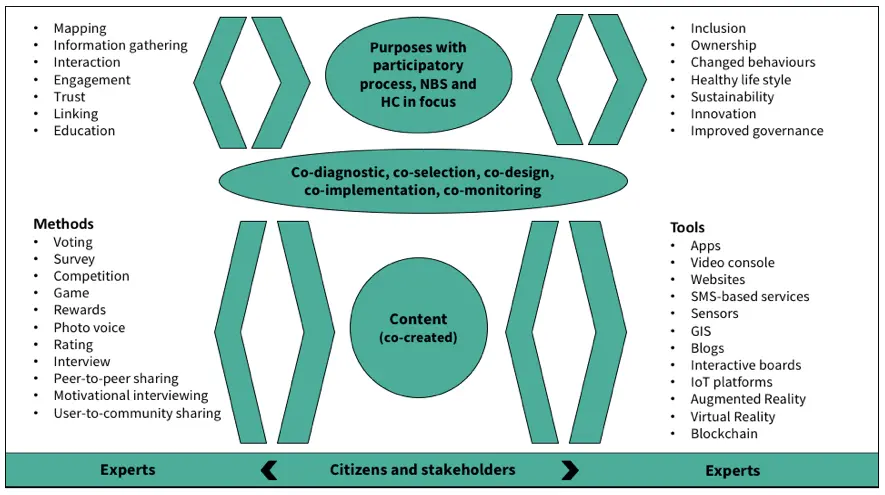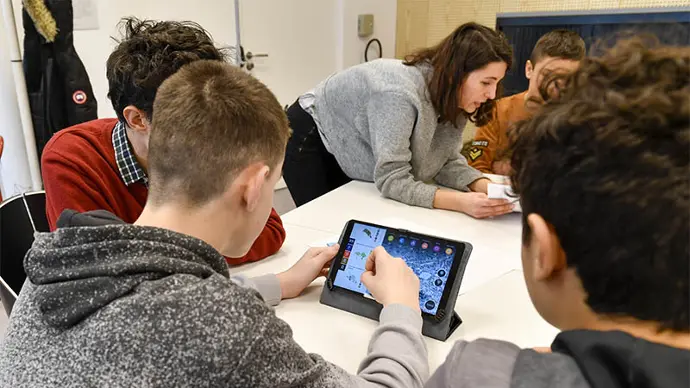[Digital Enablers] Digital enablers for citizen engagement and co-creation of NBS: Key takeaways for policy makers and city administration
__
June 15, 2021
Digital enablers for citizen engagement and co-creation of NBS: Key takeaways for policy makers and city administrations
In a newly-released URBiNAT report on digital enablers, Portfolio of Purposes, Methods, Tools, and Content: Forming Digital Enablers of NBS, key takeaways for various stakeholder groups are outlined. We zoom in on a few specific implications and key takeaways for policymakers, including city administration.
A fundamental takeaway when it comes to proceeding with digital enablers in underprivileged neighbourhoods is the need to take account of the context, culture, the diversity of attributes, and stakeholder relations. Various aspects of the local environment, here with a focus on deprived areas, require attention. This includes the status of digital infrastructure, the penetration rate of digital tools, and the level of digital literacy among various categories of people living and acting in the neighbourhood. Culture and mindset further matter gravely, e.g., when it comes to shaping attitudes and behaviours, affecting individuals, groups, and organisations. Traits within these categories influence the means for communication and trust-building, while concurrently bearing on professions, gender, age, civil status, ethnicity, interests, digital skills, competencies, and so forth.
Digital enablers offer a number of key benefits for policy makers. Part of the opportunity at hand is of technical nature, such as gaining the means of reaching a greater number of citizens, targeting special groups, gaining a better understanding of their needs and behaviours. Other aspects are subtler. Digital enablers can be unleashed to help identify and address conflicts between groups of citizens, through linking and building trust. Additionally, digital enablers can be devised and applied so as to alter the very process of urban planning, with channels put in place for the perspectives and creativity of citizens, non-experts and representatives of minorities and deprived areas to be effectively represented in decision-making processes and the enactment of NBS and Healthy corridors. Furthermore, digital enablers facilitate monitoring and data collection, providing policy makers with data and insights on citizen observations and behaviours. Several key elements should be carefully considered by policymakers, to be reflected in policymaking and initiatives, for example:
- Map the way that digital infrastructure, available digital tools and participatory culture set the stage for what digital enablers can achieve.
- Understand the importance of the citizens’ access to tools and put schemes in place for improving digital literacy.
- Where suitable, use existing, already validated digital enablers, while weighing against the value of co-creating new ones, with special value if created by citizens themselves.
- Encourage stakeholders to set up digital platforms which are independent in regard to ownership of data, management of data, etc.
- Make active use of digital enablers to underpin community identity and leverage ability to compromise, collaborate and agree on joint solutions.
- Put weight on applying digital enablers to address issues of deprived areas and disadvantaged groups, with emphasis on co-creation and high activity levels by citizens.
- Be aware that digital enablers (and relatedly, digital democracy) come with the need for investments in IT and software, skills, and knowledge development.

Next we elaborate on key implications for city administration. The municipality and its organisation meet with a multitude of complex and multifaced responsibilities. It needs to be recognised that its role incorporates that of enabling participatory processes and co-creation. Having access to diverse approaches, with the ability to tailor the most appropriate to suit a particular situation, should be a standard requirement. The range of opportunities offered by digital enablers coupled with the rapidly accumulating experience and lessons how they can be devised and applied, bring to the forefront some key takeaways, for example:
- Work proactively to establish links to citizens as a basis for effective co-diagnostic.
- Safe-guard inclusion and understand how to include and target unusual suspects.
- Manage stakeholder relations, promote dialogue and overcome resolution of conflict between opposing interests.
- Inspire and enable co-creation processes for shaping of digital enablers both via online fora and physical meetings, allowing citizens to take part in devising digital enablers.
- Connect digital enablers to indicators in order to generate valuable data for finetuning of digital enablers and future learnings.
- Create platforms capable of instigating training and inspiration for using open source and encourage use of open data and innovation.
- Collaborate with other city administrators and incorporate proven open, non-proprietary and secure platforms already being applied by other city administrators to engage citizens in co-creation.

CLICK HERE to read the other articles in this blog series
Download the full report
D3.3: Portfolio of Methods, Tools and Content - Forming Digital Enablers of NBS
This deliverable has been framed for the objective of collecting and structuring information as a basis for enhanced understanding of how to apply so-called “digital enablers” to support the co-creation process around NBS and healthy corridors in URBiNAT cities, and to draw wider lessons thereof. Despite the opportunities offered by digitalisation, as observed in ambitious plans for the development of smart cities, urban planners continue to struggle in addressing serious outstanding issues, including fragmentation and lack of engagement by disadvantaged groups. Although the application of Information and Communication Technologies (ICT) will not by itself resolve these issues, the constructive application of digital enablers can be greatly helpful. Building on the experience at hand and linking to the evolving experience of URBiNAT cities, this report sets out to cast new light on ways forward in this respect. The audience includes members of the URBiNAT project along with others interested in the project and lessons on how to address the issues at hand.